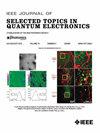Optical Fiber Amplifiers for Satellite Communications
IF 5.1
2区 工程技术
Q1 ENGINEERING, ELECTRICAL & ELECTRONIC
IEEE Journal of Selected Topics in Quantum Electronics
Pub Date : 2025-10-01
DOI:10.1109/JSTQE.2025.3616785
引用次数: 0
Abstract
Optical fiber amplifiers are crucial components for medium to long range space-based optical telecommunications networks. Current systems leverage technologies from the mature terrestrial optical fiber communications industry to enable rapid development and deployment of optical links and networks. However, link dynamics, performance metrics, and environmental conditions deviate significantly from terrestrial fiber telecommunications conditions and can vary depending on the orbit. This work reviews some of the major differences between optical fiber telecommunications and satellite free-space optical communications in the context of amplifier design and presents several examples of optical amplifiers developed to support space-based networks in both on-orbit and ground station applications. We discuss differences in the waveforms, link dynamics, and environmental conditions relevant to different space-based implementations. We also describe differences between multiple amplifier types, such as ground-based booster amplifiers and low noise optical receivers as well as amplifiers designed for various space orbital altitudes. Results and demonstrations show tremendous scalability and tailorability, exemplified in amplifiers from both CubeSat compatible compact and low-power models to larger long-range amplifiers with electrical to optical efficiencies up to 20% in the 1550 nm band.卫星通信用光纤放大器
光纤放大器是中远程天基光通信网络的关键部件。目前的系统利用成熟的地面光纤通信行业的技术,实现光链路和网络的快速开发和部署。然而,链路动态、性能指标和环境条件明显偏离地面光纤通信条件,并可能因轨道而异。这项工作回顾了光纤通信和卫星自由空间光通信在放大器设计方面的一些主要区别,并介绍了为支持在轨和地面站应用的天基网络而开发的光放大器的几个例子。我们讨论了与不同的空间实现相关的波形、链路动力学和环境条件的差异。我们还描述了多种放大器类型之间的差异,例如地基助推器放大器和低噪声光学接收器以及为各种空间轨道高度设计的放大器。结果和演示显示了巨大的可扩展性和可定制性,例如从CubeSat兼容的紧凑型和低功耗型号到更大的远程放大器,其电光效率在1550nm波段高达20%。
本文章由计算机程序翻译,如有差异,请以英文原文为准。
求助全文
约1分钟内获得全文
求助全文
来源期刊

IEEE Journal of Selected Topics in Quantum Electronics
工程技术-工程:电子与电气
CiteScore
10.60
自引率
2.00%
发文量
212
审稿时长
3 months
期刊介绍:
Papers published in the IEEE Journal of Selected Topics in Quantum Electronics fall within the broad field of science and technology of quantum electronics of a device, subsystem, or system-oriented nature. Each issue is devoted to a specific topic within this broad spectrum. Announcements of the topical areas planned for future issues, along with deadlines for receipt of manuscripts, are published in this Journal and in the IEEE Journal of Quantum Electronics. Generally, the scope of manuscripts appropriate to this Journal is the same as that for the IEEE Journal of Quantum Electronics. Manuscripts are published that report original theoretical and/or experimental research results that advance the scientific and technological base of quantum electronics devices, systems, or applications. The Journal is dedicated toward publishing research results that advance the state of the art or add to the understanding of the generation, amplification, modulation, detection, waveguiding, or propagation characteristics of coherent electromagnetic radiation having sub-millimeter and shorter wavelengths. In order to be suitable for publication in this Journal, the content of manuscripts concerned with subject-related research must have a potential impact on advancing the technological base of quantum electronic devices, systems, and/or applications. Potential authors of subject-related research have the responsibility of pointing out this potential impact. System-oriented manuscripts must be concerned with systems that perform a function previously unavailable or that outperform previously established systems that did not use quantum electronic components or concepts. Tutorial and review papers are by invitation only.
 求助内容:
求助内容: 应助结果提醒方式:
应助结果提醒方式:


